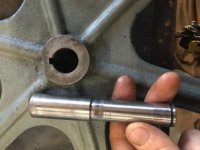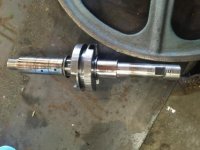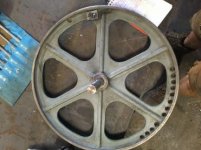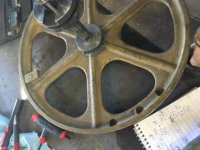calderp
Aluminum
- Joined
- Jul 22, 2011
- Location
- New Orleans
I know this has been covered extensively but I'm feeling a bit overwhelmed by options, would love some advice narrowing them down.
The issue is the output shaft on my Powermatic 143 14" high/low speed gearbox driven bandsaw. I'm turning a new shaft for the idler wheel but because it is driven by the gearbox this is a fairly complicated splined shaft that I don't have the ability to make. The input side and spline are fine but on the output side the bearing has spun and damaged the shaft and there is also serious wear where the 14" cast wheel mounts. This wear is on both the ID of the wheel bore and the OD of the shaft. This is a keyed interface.
The first problem is building the shaft back up to size. Options as I understand it are: braze up shaft and turn back to size (advantage - less heat, disadvantage - weaker repair), MIG or TIG shaft and turn back to size (more heat but stronger repair) or cut the end of the shaft off and weld on new material then turn to size. I do not know what material the shaft is, nor do I have enough experience rebuilding machines to hazard a guess. From what I've been reading and given that this is just a 14" bandsaw I would think that either building up weld or cutting and welding in a new section would be an acceptable repair. My preference is probably for building up weld simply because I don't have any 4140 or similar material on hand to replace the damaged section but if that's a better repair I can certainly get some. If I do weld up and turn back down should I overcut the shaft first so that I'm not turning on the interface between the shaft and the weld metal? Can I mig or tig with mild steel wire/filler?
The second issue, assuming the shaft is brought back to tolerance, is the wallowed out ID on the cast bandsaw wheel. The easiest solution, I think, would be to bore the hub and turn a bronze bushing. Bronze because I will need to cut the keyway into my bushing and that will need to be done either manually with a file or by setting the lathe up as a manual shaper using the carriage (is there another, better way I don't know about? We don't have any broaches or an arbor press anywhere near large enough to fit the 14" wheel).
One question is, if we go with a bronze bushing can someone hazard a guess at reasonable minimum thickness? I would prefer to leave as much of the cast hub and keyway intact as possible. Given this would it be a better idea to make the bushing in steel? If I can make a significantly thinner bushing using steel maybe it's worth the extra effort when cutting the keyway.
Is there a better or easier way to solve this problem? It seems like people really like these taper bore bushings but I don't feel confident in my ability to manually turn a good taper in the bore of the bandsaw wheel.
Any/all advice is appreciated, this is new territory for me. Thanks
The issue is the output shaft on my Powermatic 143 14" high/low speed gearbox driven bandsaw. I'm turning a new shaft for the idler wheel but because it is driven by the gearbox this is a fairly complicated splined shaft that I don't have the ability to make. The input side and spline are fine but on the output side the bearing has spun and damaged the shaft and there is also serious wear where the 14" cast wheel mounts. This wear is on both the ID of the wheel bore and the OD of the shaft. This is a keyed interface.
The first problem is building the shaft back up to size. Options as I understand it are: braze up shaft and turn back to size (advantage - less heat, disadvantage - weaker repair), MIG or TIG shaft and turn back to size (more heat but stronger repair) or cut the end of the shaft off and weld on new material then turn to size. I do not know what material the shaft is, nor do I have enough experience rebuilding machines to hazard a guess. From what I've been reading and given that this is just a 14" bandsaw I would think that either building up weld or cutting and welding in a new section would be an acceptable repair. My preference is probably for building up weld simply because I don't have any 4140 or similar material on hand to replace the damaged section but if that's a better repair I can certainly get some. If I do weld up and turn back down should I overcut the shaft first so that I'm not turning on the interface between the shaft and the weld metal? Can I mig or tig with mild steel wire/filler?
The second issue, assuming the shaft is brought back to tolerance, is the wallowed out ID on the cast bandsaw wheel. The easiest solution, I think, would be to bore the hub and turn a bronze bushing. Bronze because I will need to cut the keyway into my bushing and that will need to be done either manually with a file or by setting the lathe up as a manual shaper using the carriage (is there another, better way I don't know about? We don't have any broaches or an arbor press anywhere near large enough to fit the 14" wheel).
One question is, if we go with a bronze bushing can someone hazard a guess at reasonable minimum thickness? I would prefer to leave as much of the cast hub and keyway intact as possible. Given this would it be a better idea to make the bushing in steel? If I can make a significantly thinner bushing using steel maybe it's worth the extra effort when cutting the keyway.
Is there a better or easier way to solve this problem? It seems like people really like these taper bore bushings but I don't feel confident in my ability to manually turn a good taper in the bore of the bandsaw wheel.
Any/all advice is appreciated, this is new territory for me. Thanks






